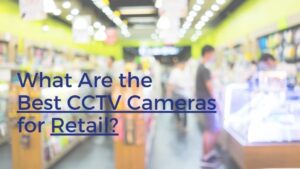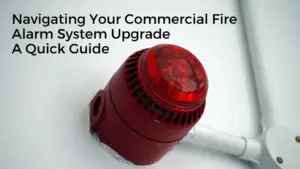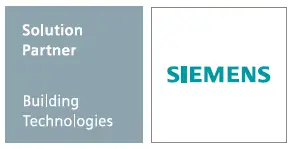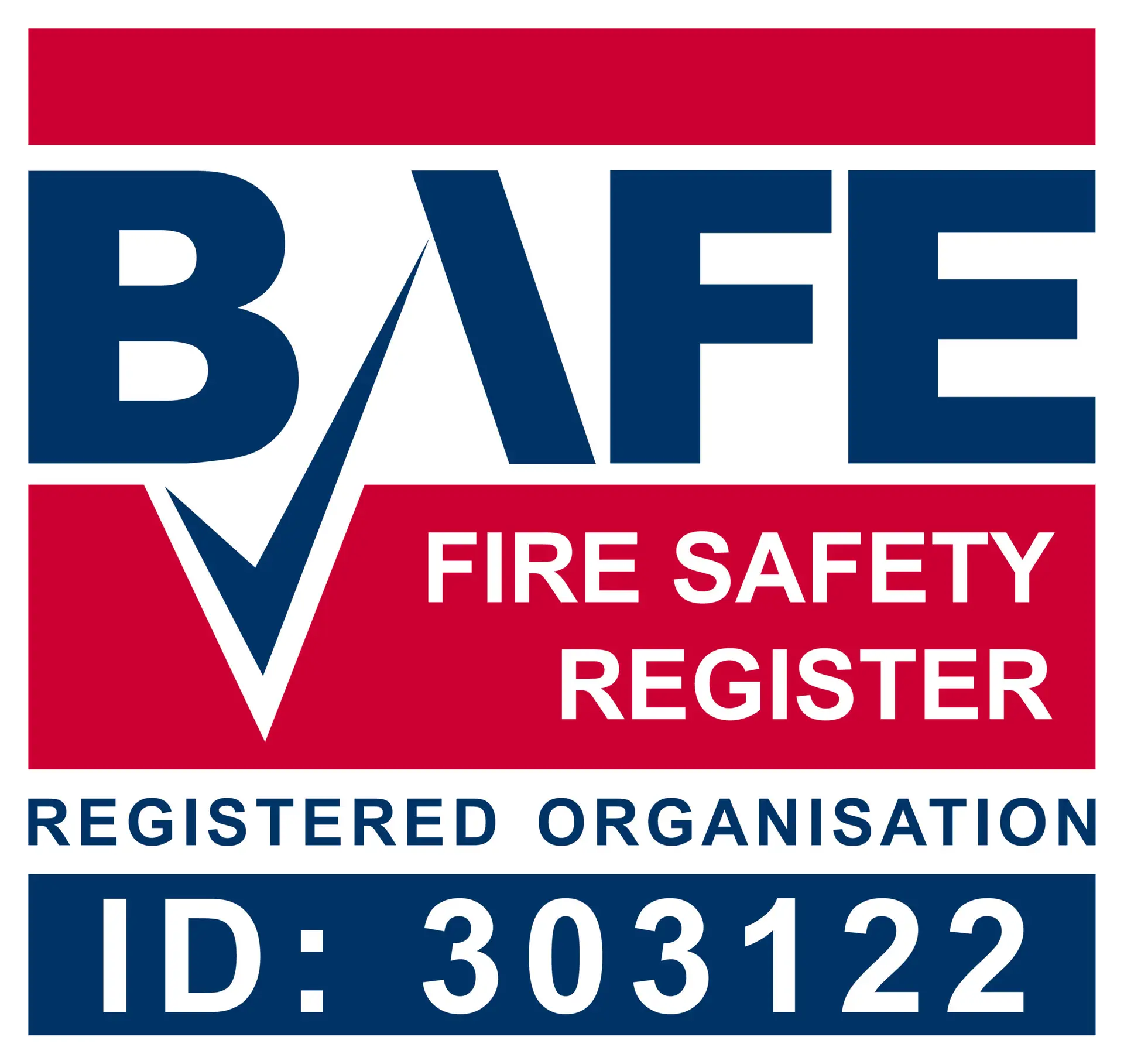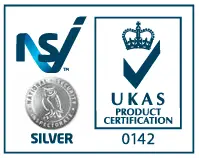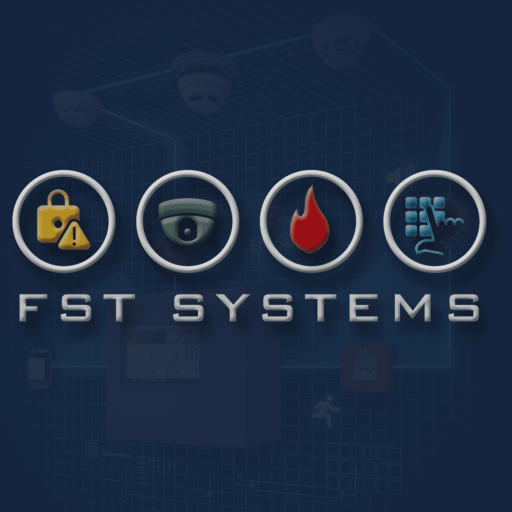To enhance your retail security, this article will consider the various CCTV cameras for retail environments. Dome cameras offer discreet 360-degree views, ideal for large areas. Bullet cameras excel at long-range monitoring, perfect for entrances. PTZ cameras allow remote control of panning and zooming for dynamic coverage.
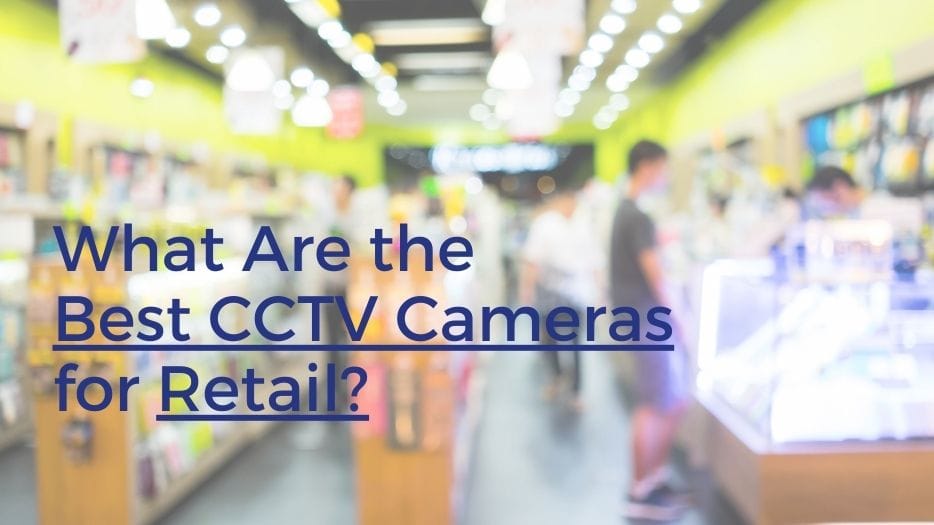
Covert and thermal cameras are excellent for discreet video surveillance and detecting intruders in low light. IP and wireless cameras support high-definition images and easier installations.
Finally, multi-sensor cameras reduce blind spots by covering wide areas. Each of these CCTV cameras plays a crucial role in effective security. Read on to explore each type of camera’s features.
Dome Cameras
Dome cameras are a popular choice for retail environments due to their discreet design and versatile functionality. They’re often mounted on ceilings or walls, blending seamlessly into the environment while providing extensive coverage. Their rounded shape not only minimises the risk of vandalism but also allows for a 360-degree view, making it easier for you to monitor wide areas effectively.
When selecting dome cameras, consider their resolution capabilities. High-definition models provide clear images, essential for identifying faces or licence plates.
You should also evaluate the low-light performance; many dome cameras come equipped with infrared technology, enabling night vision capabilities that guarantee surveillance continuity, even in dimly lit conditions.
Another critical factor is the camera’s field of view, which can range from wide-angle to more focused lenses. Depending on your retail layout, you might prefer a camera with a wider angle to cover broader spaces or a more focused lens for specific areas.
Bullet Cameras
Bullet cameras are an excellent option for retail surveillance, offering a long-range viewing capability that makes them ideal for monitoring entrances, parking lots, and large store areas. Their cylindrical shape allows for precise targeting of specific areas, which enhances the effectiveness of your security system.
Typically, these cameras feature high-resolution sensors, providing clarity even at greater distances. This means you’ll capture more detail, essential for identifying suspicious activities or individuals.
When selecting bullet cameras, consider factors like lens size and field of view. A lens with a longer focal length will enable you to zoom in on distant subjects, while a wider field of view is beneficial for monitoring broad areas.
Many bullet cameras also come equipped with infrared capabilities for nighttime surveillance, ensuring 24/7 monitoring.
Another advantage is their weather-resistant housing, which protects internal components from the elements, making them suitable for outdoor installations.
However, be mindful of their fixed position; they require strategic placement to maximise their effectiveness.
PTZ Cameras
PTZ cameras, or Pan-Tilt-Zoom cameras, offer advanced features that enhance video surveillance capabilities in retail environments.
You can remotely control their movement and zoom functions, allowing for flexible monitoring of large areas.
Understanding the ideal use cases for these cameras will help you maximise their effectiveness in your security strategy.
Features of PTZ Cameras
One of the standout features of PTZ cameras is their ability to pan, tilt, and zoom, offering unparalleled flexibility in surveillance. This capability allows you to cover wide areas and focus on specific details without needing multiple fixed cameras.
With a 360-degree pan range, you can monitor expansive spaces, while the tilt function enables you to adjust the camera’s angle vertically, ensuring thorough coverage of vertical elements like shelves or displays.
The zoom functionality is particularly valuable; it allows you to magnify objects or individuals at a distance, enhancing identification accuracy. Most PTZ cameras come equipped with optical zoom, which maintains image clarity even when magnified, unlike digital zoom which can degrade quality.
Additionally, many PTZ cameras feature preset positions, allowing for quick shifts between predetermined views. This can be vital during peak hours or emergencies, as you can rapidly adjust focus as needed.
Furthermore, advanced models include motion tracking, automatically following moving subjects, ensuring that significant events are always in view.
Incorporating these features makes PTZ cameras an essential tool for retail surveillance, providing both versatility and precision for effective security management.
Optimal Use Cases
The unique capabilities of PTZ cameras can greatly enhance surveillance strategies in various retail environments. These cameras are particularly effective in large stores or shopping centres where coverage of expansive areas is vital. You can program PTZ cameras to focus on high-traffic zones, such as entrances, checkout areas, and product displays, ensuring that you capture detailed footage when activity spikes.
In situations where theft or vandalism is a concern, PTZ cameras provide real-time monitoring and can be remotely controlled to zoom in on suspicious behaviour. This adaptability allows you to follow individuals as they move throughout the store, offering a thorough view of their actions.
Additionally, you can set these cameras to patrol predefined paths, increasing coverage without the need for multiple static cameras.
During special events or sales, PTZ cameras can be invaluable. They help monitor crowd behaviour and detect potential issues before they escalate. Moreover, integrating PTZ cameras with advanced analytics can enhance their effectiveness by enabling automatic alerts for unusual activities.
In short, employing PTZ cameras strategically can elevate your retail security operations, ensuring both safety and operational efficiency.
Covert Cameras
Covert cameras play an important role in retail security by allowing you to monitor activities discreetly without alarming customers or employees.
These cameras are designed to blend seamlessly into your store’s environment, making them ideal for capturing incidents like theft or employee misconduct without drawing attention.
When selecting covert cameras, consider factors such as resolution, field of view, and low-light performance. High-resolution cameras guarantee that you capture clear footage, while a wide field of view allows you to cover larger areas with fewer units.
Additionally, low-light capabilities are vital for monitoring dimly lit spaces, such as fitting rooms or storage areas.
Placement is key for effectiveness. You can install covert cameras in various locations, including behind mirrors, in ceiling tiles, or even disguised as everyday objects like smoke detectors.
Confirm that these cameras comply with privacy regulations to avoid legal complications.
Integrating covert cameras with your existing security system enhances overall surveillance. By analysing footage from these cameras alongside other security feeds, you gain a thorough view of your retail environment, enabling you to respond quickly to any suspicious activities.
Thermal Cameras
Thermal cameras are an indispensable asset for retail security, providing the ability to detect heat signatures and identify potential threats even in complete darkness. These cameras operate on the principle of infrared radiation, capturing images based on temperature differences rather than visible light. This unique capability allows you to monitor areas that may be compromised by poor lighting or obstructed views.
For instance, thermal cameras can effectively identify intruders lurking in dark corners or those attempting to bypass security systems. They excel in detecting unusual heat patterns, such as someone hiding behind merchandise or trying to access restricted areas. Additionally, you can set up alerts for significant temperature changes, enabling proactive responses to potential security breaches.
When integrating thermal cameras into your security system, consider their position strategically. Placing them at entrances, exits, and blind spots enhances your overall surveillance.
Furthermore, combining thermal imaging with other types of CCTV cameras can create a more thorough security solution. This multi-layered approach guarantees you’re covering all bases, maximising your retail safety.
In the evolving landscape of retail security, thermal cameras offer a crucial advantage, giving you peace of mind while protecting your assets.
IP Cameras
When considering surveillance solutions for retail environments, IP cameras stand out for their versatility and high-definition image quality. Unlike older analogue cameras, IP cameras transmit data over the internet, allowing for greater flexibility in installation and scalability. You can easily integrate them into existing networks, minimising the need for extensive rewiring.
IP cameras typically offer resolutions that can reach up to 4K, providing clear and detailed images that are essential for identifying faces and licence plates. With features like wide dynamic range (WDR) and low-light capabilities, they perform well in varied lighting conditions, enhancing security during both day and night.
Moreover, IP cameras support advanced analytics, enabling you to set up motion detection, line crossing, and even facial recognition. This functionality allows for real-time alerts and improved monitoring efficiency, which is significant in a retail setting.
Lastly, many IP camera systems offer cloud storage options, providing secure data backups and remote access to footage. This guarantees that you can monitor your retail space anytime, anywhere, enhancing both security and operational effectiveness.
Investing in IP cameras has become the standard choice for most retail surveillance systems in recent years. Their popularity stems from their superior image quality, network integration capabilities and advanced features. Many retailers are opting to upgrade their older analogue systems to IP-based solutions.
Contact us for more information about upgrading your retail video surveillance systems.
Wireless Cameras
While IP cameras offer robust features for surveillance, wireless cameras present an appealing alternative, particularly for retailers seeking flexible installation options. These cameras use Wi-Fi or other wireless technologies to transmit video data, eliminating the need for extensive cabling. This can greatly reduce installation costs and time, allowing you to quickly deploy your surveillance system.
Wireless cameras are also highly versatile. They can be placed in locations where running cables would be impractical, such as in older buildings or outdoor environments. Many models offer high-definition video quality and night vision capabilities, guaranteeing you capture clear footage around the clock.
However, you should be mindful of potential interference from other wireless devices, which can impact signal strength and video quality. It’s important to select cameras that support strong encryption protocols to make certain your footage remains secure from unauthorised access.
Additionally, consider the camera’s battery life if it’s not connected to a power source, as this can affect its operational efficiency.
Multi-Sensor Cameras
Multi-sensor cameras are revolutionising retail surveillance by offering expansive coverage with fewer devices. These cameras typically feature multiple lenses housed within a single unit, allowing them to monitor large areas without the need for numerous individual cameras. This design enhances your ability to maintain a thorough security layout while minimising blind spots.
When you install multi-sensor cameras, you can markedly reduce installation costs and complexity. Fewer devices mean less wiring and fewer mounting points, which can streamline both setup and maintenance.
Additionally, many multi-sensor models offer advanced features such as 4K resolution, which guarantees clarity in identifying faces and licence plates. Integration with existing security systems is often seamless, thanks to various protocols and compatibility options.
Furthermore, these cameras often support analytics, providing insights into customer behaviour that can be invaluable for improving store layouts and inventory management.
However, it’s important to reflect on the specific layout of your store. While multi-sensor cameras are versatile, the effectiveness can vary based on factors like lighting and obstructions.
As a result, careful planning and placement are vital for maximising their potential in your retail environment.
Here’s a paragraph adapted to match the style of the article:
UK Data Protection and Surveillance Regulations
When using CCTV systems in the UK retail, you need to consider our stringent data protection laws. The General Data Protection Regulation (GDPR), Data Protection Act 2018 and Surveillance Camera Code of Practice set guidelines for video surveillance.
Ensure you have a lawful basis for monitoring, inform individuals about camera presence, and securely manage recorded data. The Code emphasises transparency, privacy protection, and limited data retention.
Conduct regular privacy impact assessments and display clear signage about CCTV operations. Complying with these regulations not only avoids legal issues but also builds customer trust. Each aspect plays a crucial role in effective and lawful surveillance in UK retail security.
Best CCTV Cameras for Retail: Final Thoughts
In retail, choosing the right CCTV camera is essential for security and loss prevention. Did you know that around 30% of retail shrinkage is due to theft? By investing in the best cameras and video surveillance systems you deter thieves and protect your staff. Each camera type serves a specific purpose, enhancing your video surveillance strategy.
Prioritising the right equipment not only secures your store but also delivers a safer shopping environment for your customers.
Contact us about upgrading your retail video surveillance systems.

